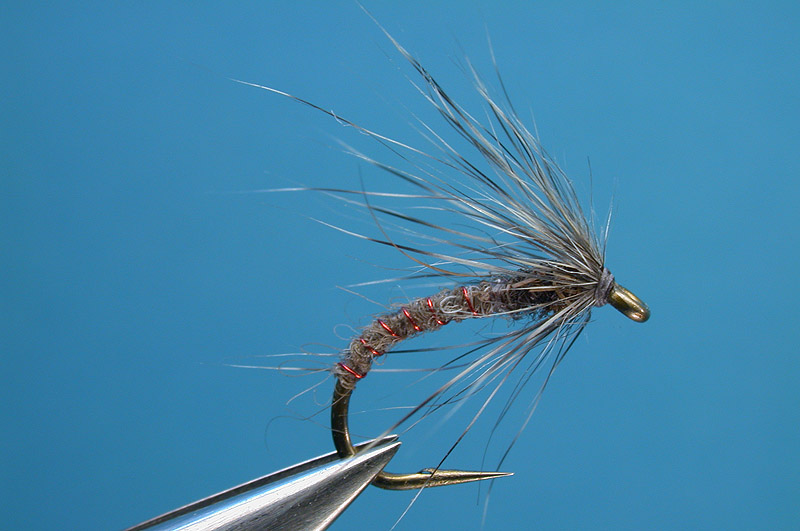Moderators: William Anderson, letumgo
-
Hans Weilenmann
- Posts: 2109
- Joined: Mon Feb 23, 2009 8:45 pm
- Location: Amstelveen, The Netherlands
-
Contact:
Post
by Hans Weilenmann » Tue Apr 14, 2009 5:25 pm
 Pining Away
Pining Away
Hook: Ashima F-45 #14 (or equivalent scud hook)
Thread: Benecchi 12/0, grey
Hair hackle: Pine squirrel
Rib: Fine orange copper wire
Abdomen: Tan dubbing
Thorax: Argentinean hare, dark grey
Cheers,
Hans W
-
letumgo
- Site Admin
- Posts: 13346
- Joined: Sat Feb 21, 2009 7:55 pm
- Location: Buffalo, New York
-
Contact:
Post
by letumgo » Tue Apr 14, 2009 7:19 pm
I'm surprised that the Pine Squirrel looks so gray. I would have thought it would be more orange in coloration. Is the European pine squirrel gray?
Great hair-hackle fly, Hans.
-
Hans Weilenmann
- Posts: 2109
- Joined: Mon Feb 23, 2009 8:45 pm
- Location: Amstelveen, The Netherlands
-
Contact:
Post
by Hans Weilenmann » Wed Apr 15, 2009 5:34 am
Ray,
I have purchased both grey and brownish pine squirrel pelts in the US, from Blue Ribbon Flies and from Wapsi.
Great material to work with!
Cheers,
Hans W
-
5feathers
- Posts: 40
- Joined: Sun Feb 22, 2009 10:08 am
- Location: Central, PA
Post
by 5feathers » Wed Apr 15, 2009 7:46 am
Hans: What technique do you use to tie on the pine squirrel hackle?
-
Hans Weilenmann
- Posts: 2109
- Joined: Mon Feb 23, 2009 8:45 pm
- Location: Amstelveen, The Netherlands
-
Contact:
Post
by Hans Weilenmann » Wed Apr 15, 2009 7:59 am
5feathers,
Split thread is always an option, but not used in this instance.
A bunch of the squirrel guard hair is tied in first, tips pointing over the eye. At this time the 'hackle' length is determined.
Next the remainder of the materials are applied. Finally the hair is pushed back over the body and positioned with a few tight wraps of thread, before finishing off the fly.
Please note that the angle and density of the front slope of the thorax plays an equally important role in how the hair hackle will angle.
Cheers,
Hans W
-
5feathers
- Posts: 40
- Joined: Sun Feb 22, 2009 10:08 am
- Location: Central, PA
Post
by 5feathers » Wed Apr 15, 2009 4:41 pm
Thanks, Hans. Did you ever try to spin the hair around the hook as the last step? I'm going to give that a try.
Bruce
-
Hans Weilenmann
- Posts: 2109
- Joined: Mon Feb 23, 2009 8:45 pm
- Location: Amstelveen, The Netherlands
-
Contact:
Post
by Hans Weilenmann » Wed Apr 15, 2009 4:44 pm
Bruce,
It is an approach, but not one I would advocate. Little control, and a lot to cover up when finishing the fly.
Cheers,
Hans W
-
William Anderson
- Site Admin
- Posts: 4569
- Joined: Mon Feb 23, 2009 3:14 pm
- Location: Ashburn, VA 20148
-
Contact:
Post
by William Anderson » Thu Apr 16, 2009 8:20 am
That's good information. I'm going to give that a try next time I find myself in front of the vise.
w
"A man should not try to eliminate his complexes, but rather come into accord with them. They are ultimately what directs his conduct in the world." Sigmund Freud.
www.WilliamsFavorite.com
-
Soft-hackle
- Site Admin
- Posts: 1874
- Joined: Sat Feb 21, 2009 10:23 am
- Location: Wellsville, NY
Post
by Soft-hackle » Sun Apr 19, 2009 9:09 pm
Hi Hans,
I've had a small problem with the technique you use. I've used it myself, and perhaps the hair I was using was a little too stiff because the head did not hold it in position after fishing a while. Don't know why it did this except for what I've mentioned already. Very nice fly for sure.
Mark
"I have the highest respect for the skilled wet-fly fisherman, as he has mastered an art of very great difficulty.” Edward R. Hewitt
http://www.libstudio.com/FS&S
-
Hans Weilenmann
- Posts: 2109
- Joined: Mon Feb 23, 2009 8:45 pm
- Location: Amstelveen, The Netherlands
-
Contact:
Post
by Hans Weilenmann » Mon Apr 20, 2009 12:12 am
Mark,
Please note that the angle and density of the front slope of the thorax plays an equally important role in how the hair hackle will angle.
You do need a gentle slope of the thorax just behind the hackle, and in some cases even a tiny amount of 'empty' space in front of the thorax, to enable the hair hackle to be positioned and fixed with the hard wraps. A permanent crease in the individual hair strands is key.
The type of hair of course also plays a part. Marten or mink are quite resilient, and need to be brought to order sharply. The pine squirrel used in the Pining Away is more obedient

Cheers,
Hans W

